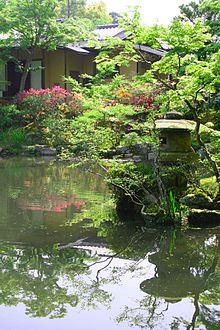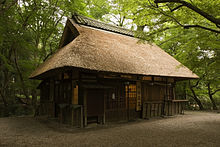- Nara Park
-
Nara Park (奈良公園 Nara Kōen) is a public park located in the city of Nara, Japan, at the foot of Mount Wakakusa, established in 1880. Administratively, the park is under the control of Nara Prefecture. The park is one of the "Places of Scenic Beauty" designated by the Ministry of Education, Culture, Sports, Science and Technology (MEXT). The over 1,200 wild sika deer (シカ or 鹿 shika) freely roaming around in the park is also under designation of MEXT, classified as a "Natural Monument." While the official size of the park is about 502 ha, the area including the grounds of Tōdai-ji, Kōfuku-ji and Kasuga Shrine, which are either on the edge or surrounded by Nara Park, is as large as 660 ha.
Jinrikisha (人力車, or ricksha) services can be found nearby the entrances to popular sites as Tōdai-ji or Kōfuku-ji.
While Nara Park is usually associated with the broad areas of the temples and the park proper, there are now previously private gardens open to public. These gardens make use of the temple buildings as adjunct features of their landscapes.
The park is also home to the Nara National Museum and Todai-ji, where the largest wooden building in the world houses a 50' tall statue of Buddha.[1]
Deer
According to local folklore, deer from this area were considered sacred due to a visit from one of the four gods of Kasuga Shrine, Takenomikazuchi-no-mikoto.[2] He was said to have been invited from Kashima, Ibaraki,[3] and appeared on Mt. Mikasa-yama riding a white deer. From that point, the deer were considered divine and sacred by both Kasuga Shrine and Kōfuku-ji.[3]
Killing one of these sacred deer was a capital offense punishable by death up until 1637, the last recorded date of that law having been enforced.[3]
Post World War II the deer were officially stripped of their sacred/divine status,[3] and were instead designated as National Treasures and are protected as such.
Today, visitors can purchase deer-crackers (鹿煎餅 Shika-senbei) to feed the deer in the park.[2]
References
External links
Coordinates: 34°41′08″N 135°50′36″E / 34.68556°N 135.84333°E
Categories:- Urban public parks
- Parks and gardens in Nara Prefecture
Wikimedia Foundation. 2010.



